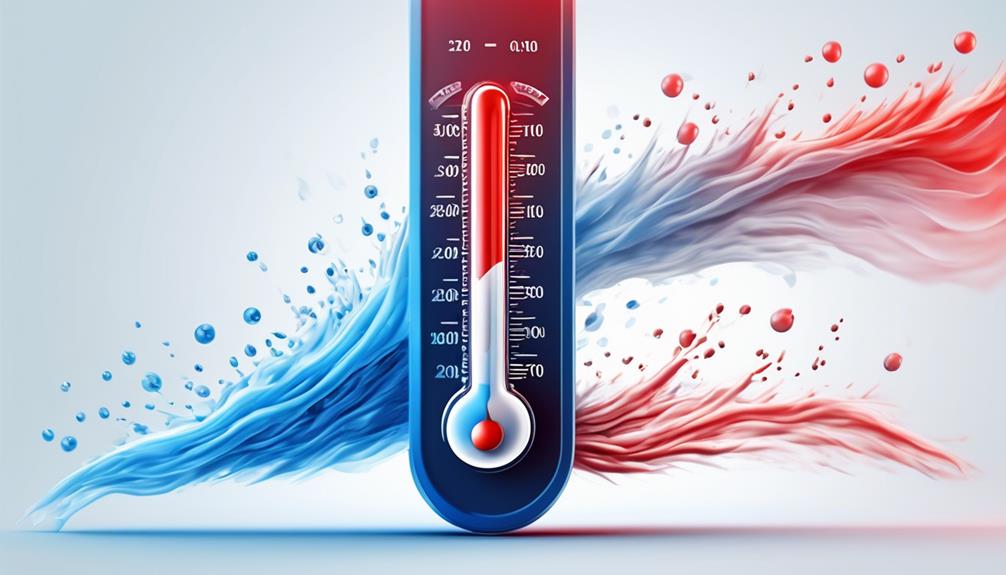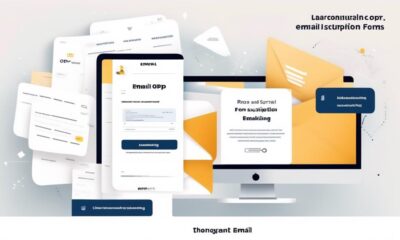Email Warmup
Warm up Domain for Cold Email
Dive into the art of domain warm-up for cold email campaigns and discover the crucial strategies for unlocking deliverability success.

As we delve into the vast realm of email marketing, it is crucial to approach the domain warm-up process with caution and precision.
The process of establishing a new domain's reputation to ensure deliverability is a multifaceted challenge that demands attention to detail and strategic planning.
But how can we effectively warm up a domain to maximize our email outreach potential?
Let's explore the intricacies of this essential step in the realm of cold email campaigns and uncover the key strategies that can elevate our deliverability rates and engagement metrics.
Key Takeaways
- Domain warm-up is essential for establishing a positive email reputation for a new domain.
- Gradually increasing email send volumes demonstrates legitimacy and builds trust with ISPs and ESPs.
- Monitoring reputation factors and implementing authentication protocols are crucial for maintaining a good sender reputation.
- Utilizing automated warm-up tools can streamline the warm-up process and improve deliverability.
What Is Domain Warm-Up?
We begin our journey into the world of domain warm-up by understanding its crucial role in establishing a positive email reputation for our new domain.
When we send cold emails from a new domain, it lacks a reputation with Internet Service Providers (ISPs) and Email Service Providers (ESPs). This absence of reputation can trigger suspicion and lead to our emails being blocked or sent to the recipients' spam folders.
Domain warm-up is the process of gradually increasing our email send volumes from the new domain over a period of time. By doing so, we demonstrate to ISPs and ESPs that we're a legitimate sender with genuine intentions, aiming to build trust and establish a positive domain reputation.
As these entities observe our sending behavior and the engagement levels of our recipients, they gradually allow increased email send volumes. This process is critical for ensuring that our emails reach the recipients' inboxes instead of being filtered out.
Ultimately, domain warm-up is essential for improving our domain reputation and guaranteeing email deliverability for our cold email campaigns.
Importance of Domain Warm-up

When it comes to email marketing, the importance of domain warm-up can't be overstated.
Establishing a positive email reputation and building trust with ISPs and ESPs is crucial for successful campaigns.
Without a good sender reputation, emails may be blocked or labeled as spam, making it essential to gradually increase sending volumes and avoid suspicions.
Importance of Reputation
Establishing a positive email reputation through domain warm-up is crucial for avoiding suspicions of spamming behavior and ensuring successful email delivery. A new domain starts with a neutral reputation, so engaging in manual warm-up processes and configuring SPF and DKIM records is essential.
Choosing the right email account and collecting responses help in maintaining an active email account, contributing to a positive sender reputation. Factors impacting domain reputation, such as delete rate, spam reports, unsubscribe requests, email content, engagement rate, blacklists, and bounce rate, must be carefully monitored.
Building Email Credibility
Transitioning from the discussion of reputation, we pivot to the critical aspect of building email credibility through the domain warm-up process.
Warming up an email domain is essential for establishing a positive domain and IP reputation, which ultimately improves your domain reputation. This gradual increase in email send volumes from a new domain is a strategic move to gain trust from ISPs and ESPs.
Without a proper warm-up, new domains may trigger suspicions and lead to email blocking, making it crucial for successful email campaigns. The duration of the warm-up period varies based on the email provider, emphasizing the need for patience and strategic planning.
Ultimately, building email credibility through domain warm-up is vital for gaining trust and establishing a positive email reputation, significantly impacting overall email deliverability.
Avoiding Spam Filters
To maximize email deliverability and avoid triggering spam filters, domain warm-up is a critical process that demands careful attention and strategic execution. Here are four key steps to successfully avoid spam filters and establish a positive reputation for your domain:
- Gradually increase email volume:
- Start by sending a small volume of emails
- Gradually ramp up over time to demonstrate responsible and legitimate email sending behavior.
- Monitor engagement metrics:
- Pay close attention to open rates, click-through rates, and spam complaints
- Gauge recipient interaction
- Adjust sending practices accordingly.
- Authenticate your domain:
- Implement SPF, DKIM, and DMARC authentication
- Verify the legitimacy of your email domain
- Signal to email providers that your emails are trustworthy.
- Maintain consistency:
- Regularly send relevant and valuable content to recipients
- Maintain a positive reputation
- Uphold consistent sending practices.
Domain Reputation Impact

When it comes to cold email campaigns, domain reputation holds significant sway over our success. Our email deliverability and ability to avoid spam filters hinge on the reputation of our domain.
Email Deliverability Impact
Establishing a positive domain reputation through effective email warm-up is crucial for ensuring high deliverability rates and inbox placement. When it comes to email deliverability impact, several key factors come into play:
- Content Quality: Providing relevant, engaging, and valuable content can help improve email deliverability and recipient engagement.
- List Hygiene: Regularly cleaning email lists to remove inactive or invalid addresses can prevent high bounce rates and maintain a positive sending reputation.
- Authentication: Implementing email authentication protocols such as SPF, DKIM, and DMARC can enhance email deliverability by verifying the sender's identity.
- Monitoring Metrics: Keeping a close eye on metrics like open rates, click-through rates, and spam complaints can provide insights into email performance and reputation, guiding adjustments for better deliverability.
Spam Filter Avoidance
Building a positive sender reputation through effective warm-up practices is crucial for ensuring high deliverability rates. One key aspect to consider is the impact of domain reputation on avoiding spam filters.
When sending cold emails, it's essential to understand that a new domain lacks a reputation, making it susceptible to being flagged as spam. To avoid this, gradually increase the volume of emails sent during the warm-up period. Email providers view mass emails from new domains as suspicious, so it's advisable to wait at least 12 weeks before launching outbound campaigns.
Additionally, factors such as delete rate, spam reports, unsubscribe requests, email content, engagement rate, and blacklists significantly influence domain reputation. By prioritizing spam filter avoidance and implementing an effective warm-up domain strategy, you can establish a positive sender reputation and improve email deliverability.
Best Practices for Email Domain Warming

Implementing a gradual increase in the number of emails sent from a new email account is crucial to avoid being blocked by email providers when warming up the domain. When it comes to warming up an email domain for cold email outreach, it's essential to follow best practices to ensure deliverability and avoid being marked as spam. Here are some key practices to keep in mind:
- Gradual Increase: Start by manually sending a few emails per day and gradually increase the volume over a few weeks. This gradual approach helps establish a positive reputation with email providers.
- Sender Reputation: Building a good sender reputation is vital. Avoid sending out cold sales emails during the warm-up phase to prevent negative interactions that could harm your reputation.
- Configuration: Configure SPF and DKIM records to improve email deliverability. Additionally, consider using a dedicated IP address for better reputation management.
- List Management: Understand that domain reputation isn't the only factor affecting email deliverability. Clean email lists regularly to improve open rates and save resources.
Manual Email Account Warm-up

The process of gradually increasing the email volume from a new account plays a crucial role in establishing a positive sender reputation and ensuring successful email campaigns.
Manual Email Account Warm-up is essential in the warm-up domain for cold email. Sending a large volume of emails from a new account right away can result in being blocked by the email provider, making the warm-up process crucial. The warm-up period's length depends on the email provider and can range from a few days to several weeks, emphasizing the need for patience and strategic planning.
Building a good sender reputation is essential for successful email campaigns, highlighting the significance of the warm-up process in achieving this goal. Manual warm-up involves strategies like reaching out to friends and business partners to reconnect personally and avoiding sales emails during the warm-up phase to build credibility with different providers.
Through manual email account warm-up, we can gradually establish a positive sender reputation, laying the foundation for successful cold email campaigns.
Automated Email Account Warm-up Tools

Let's talk about the importance of automated email account warm-up tools and how they can significantly impact your sender reputation.
We'll also explore the best warm-up tools available and how they can help you avoid being flagged as spam by email providers.
It's crucial to understand how these tools can improve deliverability and ensure that your emails land in the recipient's inbox, ultimately leading to more effective outreach.
Email Warm-Up Importance
Using automated email account warm-up tools can significantly streamline and optimize the process of building a positive sender reputation and maximizing email deliverability. When considering the importance of email warm-up, it's essential to understand the benefits it offers:
- Enhanced Sender Reputation: Proper warm-up establishes credibility and trust with ISPs and ESPs, increasing the likelihood of successful email campaigns.
- Improved Domain Reputation: New domains start with a neutral reputation and need time to earn trust, making warm-up crucial for maximizing deliverability.
- Essential Configuration: Setting up SPF and DKIM records, using a suitable email account, and ensuring accurate 'from' lines and signatures are vital in the warm-up process.
- Automation for Efficiency: Automated tools simulate real user behavior, gradually increasing email volume, and optimizing the warm-up process for improved results.
Understanding these aspects highlights the significance of email warm-up in the cold email domain.
Best Warm-Up Tools
As we explore the realm of automated email account warm-up tools, it becomes evident that their utilization is crucial for establishing a positive sender reputation and enhancing domain deliverability.
Automated warm-up tools gradually increase email sending volume, crucial for avoiding being blocked by email providers due to suspicious mass email sending from a new domain. The length of the warm-up period varies depending on the email provider, typically ranging from a few days to several weeks.
These tools automate the warm-up process, including engagement with the inbox, collecting responses, and building domain reputation. Options like Trulyinbox, Warmy.io, and Mailwarm provide automated set-up, advanced reports, and tailored warm-up schedules to optimize the warm-up process.
Leveraging these warm-up tools is essential for effectively warming up domains and ensuring successful cold email outreach campaigns.
Avoiding Spam Filters
To effectively navigate past spam filters, one must harness the power of automated email account warm-up tools to establish a strong sender reputation and elevate domain deliverability. Here's how to do it:
- Gradual Increase in Email Send Volumes: Automated warm-up tools gradually increase email send volumes to establish a positive email reputation for a new domain.
- Gain Trust from ISPs and ESPs: These tools help gain trust from Internet Service Providers (ISPs) and Email Service Providers (ESPs) to ensure emails are delivered to recipients' inboxes and avoid being labeled as spam.
- Time-Saving and Consistent Engagement: Using automated warm-up processes saves time and ensures consistent engagement to build a good sender reputation.
- Efficient and Effective Results: Automated warm-up is recommended for efficient and effective results in establishing domain reputation and improving email deliverability.
Stopping Email Account Warm-up

After successfully completing the warm-up process for your email account, it's crucial to maintain the gained sender reputation to ensure continued deliverability and engagement. Stopping the email account warm-up abruptly can negatively impact the sender reputation and result in a decline in email deliverability.
It's essential to continue gradually increasing the volume of emails sent, maintaining a consistent sending schedule, and engaging with recipients to solidify the positive reputation established during the warm-up period.
Once the warm-up process is complete, transitioning to regular email campaigns should be done strategically. Sudden spikes in email volume or drastic changes in sending behavior can trigger red flags with email providers and undo the progress made during the warm-up process.
It's important to continue nurturing the relationships built with recipients, encouraging replies, and actively engaging with the inbox to demonstrate a genuine and positive sender reputation.
Out-of-the-Box Email Warm-up Strategies

Maintaining a positive sender reputation post-warm-up is essential as we explore innovative strategies for out-of-the-box email warm-up. To optimize the domain warm-up process, we must think outside the box and consider the following strategies:
- Personalized Engagement: Engage in personalized interactions with recipients, avoiding generic or sales-focused content. This approach helps build genuine connections and credibility with the audience.
- Behavior-based Segmentation: Implement segmentation based on recipient behavior, such as email open rates and click-through rates. Tailoring content to specific segments enhances relevance and improves engagement.
- Interactive Content: Incorporate interactive elements like surveys, polls, or quizzes in emails. Interactive content encourages active participation from recipients, fostering a sense of involvement and interest.
- Social Media Integration: Integrate social media platforms into email campaigns to create a cohesive brand experience. Leveraging social channels for engagement reinforces brand visibility and encourages cross-platform interactions.
Steps for Warming Up a New Domain

When establishing a new domain, a gradual and strategic approach to warming up the domain is critical for building a positive sender reputation and ensuring successful email delivery.
To achieve this, we follow specific steps to ease the new domain into the email ecosystem.
Firstly, we begin by sending a low volume of emails and gradually increasing this number over time. This cautious approach prevents the new domain from being flagged as suspicious or spammy, thus avoiding potential blocking by email providers.
Secondly, during the warm-up phase, it's essential to focus on providing valuable and engaging content rather than sales-driven emails. By doing so, we aim to encourage genuine interactions and replies, which can positively impact the domain's reputation.
Additionally, we adhere to the specific warm-up period recommended by email providers, which can range from a few days to several weeks. This period allows the domain to establish a positive email reputation, enhancing deliverability and increasing the likelihood of emails reaching recipients' inboxes.
Ultimately, by carefully navigating the warm-up process, we pave the way for a successful email campaign from the new domain.
Taking Email Deliverability to the Next Level

As we continue to build upon our domain's positive email reputation through the warm-up process, we're now ready to elevate our email deliverability to the next level. Achieving top-tier email deliverability is crucial for the success of any cold email campaign.
Here are four essential steps to take our email deliverability to new heights:
- Maintain Engagement: We'll focus on crafting engaging, relevant content that encourages recipients to interact with our emails. This can include personalized subject lines, compelling visuals, and clear calls to action.
- Monitor Reputation: We'll closely monitor our domain reputation and email performance metrics. By regularly analyzing open rates, click-through rates, and spam complaints, we can identify any issues and take proactive steps to maintain a positive reputation.
- Authenticate Emails: Implementing email authentication protocols such as SPF, DKIM, and DMARC will help verify our domain's legitimacy and prevent spoofing and phishing attempts. This also signals to ISPs that our emails are trustworthy.
- Optimize Deliverability: We'll continuously optimize our email deliverability by managing bounces, removing inactive subscribers, and adhering to best practices for list hygiene. Additionally, we'll utilize email deliverability tools to identify and address any deliverability challenges promptly.
Frequently Asked Questions
How Do I Warm up My Domain for Cold Email?
We warm up our domain for cold email by gradually increasing the number of emails sent from a new email account to avoid being blocked. It's crucial to build a good sender reputation, especially from a new domain.
We choose an email account that meets sending requirements and set up SPF and DKIM records to improve email deliverability.
Starting with manual sending and avoiding sales emails during the warm-up phase helps establish a positive sender reputation.
What Is the Best Domain for Cold Email?
The best domain for cold email is one with a positive reputation and sender trust. We've found that gradual warm-up processes work wonders in establishing a positive email reputation and gaining trust from ISPs and ESPs.
Factors impacting domain reputation include delete rate, spam reports, unsubscribe requests, email content, engagement rate, blacklists, and bounce rate.
Our top practices for email domain warming include:
- Knowing sending limits
- Implementing email authentication
- Providing high-quality content
- Cleaning email lists
- Using a dedicated IP address.
What Is a New Email Domain Warm Up?
We understand that a new email domain warm-up is a gradual process of establishing a positive sender reputation for a new email account.
It involves sending a gradually increasing number of emails to gain trust from ISPs and ESPs, ensuring successful email campaigns.
This process is crucial for avoiding being blocked by email providers and increasing deliverability to recipients' inboxes.
Careful planning and execution are essential due to the varying warm-up period lengths.
How Do I Warm up My New Email Address?
We warm up our new email address by gradually increasing the number of emails we send. This helps us avoid being labeled as spam and builds a good sender reputation, crucial for successful email campaigns.
The warm-up period varies depending on the email provider, usually lasting from a few days to several weeks.
Factors impacting our domain reputation include:
- Delete rate
- Spam reports
- Unsubscribe requests
- Email content
- Engagement rate
- Blacklists
- Bounce rate.
Can Cold Email Warming Techniques Help in Warming up an Email Address?
Yes, cold email warming techniques can definitely help in warming up email addresses. By gradually sending relevant and valuable content, engaging with the recipient, and respecting their preferences, you can improve your sender reputation and increase the chances of your emails landing in the inbox instead of the spam folder.
What is the Importance of Warm Up Domain for Cold Email?
When starting a cold email campaign, following tips for email domain warmup is crucial. Building a positive sending reputation and avoiding spam filters requires a gradual increase in email volume. A warm-up domain allows for establishing credibility and trust with internet service providers, improving email deliverability and overall campaign success.
Conclusion
In conclusion, domain warm-up is crucial for ensuring email deliverability and reaching our target audience.
By following best practices and gradually increasing our email sending volume, we can establish a positive domain reputation and avoid being labeled as spam.
With authenticating our email account, providing high-quality content, and engaging with recipients, we can take our email deliverability to the next level.
Let's warm up our domain and build trust with ISPs and ESPs for successful email outreach.
Natali – Editor in Chief (Strategy and Mastery, AI Expert) Natali, our Editor in Chief, is the driving force behind our content’s strategic direction. With a keen eye for detail and a deep understanding of market trends, Natali ensures that our content is top-notch and strategically aligned with our client’s goals. Her expertise in AI helps to seamlessly integrate advanced technology into our marketing strategies, pushing the boundaries of conventional marketing.
Email Warmup
Email Warm up Meaning
Get ready to unravel the mysteries of Email Warm-up Meaning and discover how it can transform your email campaigns in surprising ways.

The idea of warming up an email is similar to building a solid foundation for upcoming success.
The process involves more than just sending out emails; it's about strategically nurturing your sender reputation to ensure your messages land where they are intended.
However, the intricacies of email warm-up go beyond mere sending; there are nuances to explore that can significantly impact your email deliverability and engagement rates.
Curious to uncover the finer details that can shape your email campaigns for the better?
Key Takeaways
- Email warm up is crucial for establishing good sender reputation.
- Gradually increasing email volume and engagement enhances email deliverability.
- Email warm up improves engagement metrics like open rates and click-through rates.
- Configuring SPF and DKIM records and monitoring deliverability metrics are best practices.
Definition of Email Warm Up
In email marketing, the term 'Email Warm Up' refers to the strategic process used to enhance the reputation and deliverability of a new or inactive email account.
Email warm-up is crucial for establishing a good sender reputation, which is essential for getting past spam filters and reaching recipients' inboxes successfully.
This process involves gradually increasing the volume of emails sent from the new account while engaging with them by replying and marking them as important.
The goal is to signal to email providers that the account is legitimate and trustworthy, thereby improving email deliverability.
Importance of Email Warm Up

Enhancing email deliverability through a well-executed warm-up process is crucial for establishing trust and reaching recipients' inboxes effectively. Email warm-up is vital for ensuring that your emails aren't marked as spam and have a higher chance of being delivered directly to the inbox.
Here are some key reasons why email warm-up is essential:
- Building a Positive Sender Reputation: Gradually increasing the volume of emails sent from a new or inactive email account helps in creating a positive sender reputation.
- Avoiding Spam Filters: Proper warm-up procedures reduce the risk of emails being flagged as spam and increase the chances of reaching the intended recipients.
- Preparing for Cold Email Outreach: Email warm-up is particularly important for successful cold email outreach campaigns, as it helps in establishing credibility with email service providers and internet service providers.
- Improving Email Performance Metrics: A well-warmed email account leads to improved email deliverability, increased sending limits, and higher engagement metrics like open rates, click-through rates, and reply rates.
Benefits of Email Warm Up
Establishing a robust email warm-up process not only enhances deliverability and sender reputation but also yields significant benefits for email marketing campaigns.
By warming up your inbox, you can improve sender reputation, leading to increased email deliverability and avoiding spam filters. This positive reputation with email service providers enhances the chances of your emails reaching recipients' inboxes.
Additionally, warming up an email account increases sending limits, enabling you to send larger volumes of emails effectively.
Moreover, warm-up processes contribute to higher engagement metrics such as open rates, click-through rates, and click-to-open rates, fostering better interactions with your audience.
Building a positive reputation through email warm-up is crucial for successful cold email outreach, as it establishes credibility and trust with recipients.
Best Practices for Email Warm Up

Utilizing a strategic combination of automated and manual methods is key to effective email warm-up practices. When implementing best practices for email warm-up, consider the following:
- Gradual Increase in Sending Volume: Begin by sending a small number of emails each day and gradually ramp up the volume to avoid triggering spam filters.
- Maintain Sender Reputation: Engage with recipients by replying to emails, marking messages as important, and ensuring that your content is relevant and valuable.
- Configure SPF and DKIM Records: Properly set up SPF and DKIM records for your domain to authenticate your emails and improve deliverability.
- Monitor Deliverability Metrics: Keep a close eye on key metrics like open rates, click-through rates, and spam complaints to gauge the effectiveness of your warm-up process.
Key Considerations for Email Warm Up
As we shift our focus to 'Key Considerations for Email Warm Up', it's crucial to emphasize the strategic implementation of methods to maintain a high email reputation. When considering the key factors for email warm-up, one must prioritize the reputation of the email account.
It's essential to start slowly increasing the number of emails sent daily to avoid triggering spam filters. By warming up your email, you're essentially establishing trust with Internet Service Providers (ISPs) and inbox providers.
Additionally, when sending cold emails or emails on behalf of others, ensure that the sending volume aligns with daily sending limits to prevent being marked as spam. Utilizing an email warm-up tool can assist in automating this process and monitoring the sender's reputation.
Furthermore, integrating a spam checker tool into your warm-up routine can help maintain a positive email account reputation.
Frequently Asked Questions
How Do You Write a Warm up Email?
When writing a warm-up email, we focus on establishing a connection with the recipient by being concise, relevant, and engaging. We ensure the subject line is attention-grabbing, the content is personalized, and the call-to-action is clear.
Why Do We Warm up Emails?
We warm up emails to build a good sender reputation and prepare new accounts for sending at scale. Gradually increasing email volume helps establish a positive reputation and avoid being blocked. Utilizing an email warm-up service, whether automated or manual, can boost deliverability and engagement rates.
Choosing the right tool is crucial for generating interest, building trust, and enhancing sender reputation. Real mailbox responses improve credibility by simulating regular activity.
How Long Does Email Warm up Take?
Reaching maximum deliverability potential through email warm-up typically takes 8 to 12 weeks. This process enhances our reputation with ESPs and ISPs, increasing the likelihood of inbox delivery. It addresses issues like being blocked by spam filters and builds a positive sender reputation.
Automated email warm-up can expedite the process in 14 days, whereas manual warm-up involves gradually engaging high-reputation inboxes.
A smart email warm-up service enhances deliverability, boosts sales, and establishes trust.
How Do I Warm up My New Email?
When warming up a new email, we start by sending a small number of emails daily, replying to them, and marking them as important. This process typically takes 8 to 12 weeks to achieve maximum deliverability potential.
It enhances the chances of our messages landing directly in recipients' inboxes, addressing issues of spam filter blocking, and facilitating effective cold email outreach.
Email warm-up is a crucial step in establishing trust and reputation for successful campaigns.
How Does Mirasee’s Warm up Cold Email Technique Relate to the Meaning of Email Warm up?
When it comes to email warm up, Mirasee’s warm up email technique is a game-changer. By personalizing emails and connecting with the recipient before pitching, the sender can establish rapport and trust. This approach aligns perfectly with the true meaning of email warm up, which is about building relationships before making sales pitches.
Conclusion
In conclusion, email warm-up is crucial for establishing trust and improving deliverability for new or inactive email accounts.
By following best practices and engaging with recipients, businesses can increase the effectiveness of their email outreach campaigns.
But have you considered how email warm-up could be the missing piece to boosting your email marketing success?
Natali – Editor in Chief (Strategy and Mastery, AI Expert) Natali, our Editor in Chief, is the driving force behind our content’s strategic direction. With a keen eye for detail and a deep understanding of market trends, Natali ensures that our content is top-notch and strategically aligned with our client’s goals. Her expertise in AI helps to seamlessly integrate advanced technology into our marketing strategies, pushing the boundaries of conventional marketing.
Email Warmup
Master How to Warm up a Domain for Email Success
Dive into the art of domain warm-up for emails, unraveling strategies to ignite engagement and boost deliverability.

Beginning the process of warming up a domain for email is similar to igniting a flame in the vast realm of the digital world.
The initial steps are crucial, but the real challenge lies in sustaining that warmth over time.
Ensuring that our emails reach the right audience and resonate with them requires a strategic approach that evolves with the ever-changing email ecosystem.
Let’s explore the intricacies of domain warm-up and how we can nurture it to spark lasting connections with our recipients.
Key Takeaways
- Gradually increasing email volumes during domain warm-up is important for establishing a positive reputation.
- Implementing email authentication protocols and delivering high-quality content contribute to a successful warm-up process.
- Avoiding spammy content and using warm-up tools can help improve domain reputation.
- Regularly cleaning email lists and segmenting based on engagement levels are crucial for maintaining a good sending reputation.
Importance of Domain Warm-up
Gradually increasing email volumes during domain warm-up is crucial to establish a positive email reputation and ensure deliverability to recipients’ inboxes. Domain warm-up plays a pivotal role in the email marketing strategy as it sets the foundation for a strong sending reputation.
By gradually ramping up email volumes, a domain can improve its reputation with Internet Service Providers (ISPs) and Email Service Providers (ESPs). This process is essential to gain trust and avoid being flagged as spam. Starting with a new domain without proper warm-up can lead to low deliverability rates and a tarnished reputation.
Monitoring key metrics such as delete rate, spam reports, and engagement rate is vital during the warm-up phase to make necessary adjustments and enhance domain reputation. Implementing email authentication protocols and delivering high-quality content further contribute to a successful warm-up process.
Steps for Domain Reputation Improvement

To enhance domain reputation and ensure optimal deliverability, it is essential to gradually increase email send volumes from a new or cold email domain. Implementing email authentication mechanisms like SPF, DKIM, and DMARC is crucial for establishing domain reliability. Providing high-quality, relevant, and personalized content helps engage recipients and improve your domain reputation. Regularly cleaning email lists is essential for enhancing open rates and email deliverability. Utilizing a warm-up tool automates and optimizes the domain warming process, aiding in building your reputation effectively.
Steps for Domain Reputation Improvement Description Importance Gradually increase send volumes Establish a good sending reputation by slowly ramping up email volume. Crucial for domain warming process. Implement email authentication Use SPF, DKIM, and DMARC to ensure domain reliability and email security. Critical for email deliverability. Provide high-quality content Engage recipients with relevant content to improve domain reputation. Enhances recipient interaction. Clean email lists regularly Improve open rates and deliverability by maintaining clean email lists. Essential for successful email campaigns. Use a warm-up tool Automate and optimize the domain warming process for building reputation. Streamlines the domain warm-up process.
Avoiding Spammy Content
Establishing a reputable domain is crucial for avoiding spammy content in email campaigns. This can be achieved by implementing email authentication mechanisms and providing high-quality content.
To improve your email warming process and gradually increase your domain’s reputation, it’s essential to be mindful of the email content you send out. Avoid using spammy words or phrases that could trigger spam filters and harm your domain’s reputation.
Ensure that your email content is of high quality, relevant, and personalized to the recipient. Implementing proper email authentication protocols like SPF, DKIM, and DMARC can also help in avoiding spammy content.
Additionally, refrain from including too many links or attachments in your emails, as this can raise red flags with spam filters.
Utilizing Warm-up Tools

We leverage email warm-up tools to automate and optimize the domain warm-up process efficiently.
- By using warm-up tools, we can monitor the warming process, track performance, and make data-driven adjustments.
- These tools provide insights into our warm-up strategy’s effectiveness, allowing us to fine-tune our approach for optimal results.
- Regularly analyzing the data and metrics offered by warm-up tools enables us to gauge our progress accurately.
Utilizing warm-up tools is essential in establishing a good sending reputation for our email domain. It’s crucial for the success of our email campaigns and overall sender health.
These tools help us maintain a strong sending address, increasing the likelihood of our messages reaching recipients’ inboxes. Additionally, warm-up tools assist in building trust with Internet Service Providers (ISPs) and ensuring that our IP address isn’t associated with spam or blacklisted activities.
Clean Email List Maintenance
In optimizing our email domain warming process, maintaining a clean email list is paramount for ensuring deliverability and engagement. Clean email list maintenance involves:
- Regularly removing invalid or inactive email addresses
- Utilizing email verification tools for validity checks
- Segmenting based on engagement levels
- Implementing double opt-in procedures
By monitoring metrics like open and click-through rates, inactive subscribers can be identified and purged to enhance list quality.
New businesses embarking on email campaigns should prioritize clean email list maintenance to avoid falling into the trap of sending cold emails. It’s a good idea to start with a warm-up phase where a small number of emails are sent initially, gradually increasing the volume to acclimate the domain automatically. We recommend:
- Sending emails to engaged subscribers to build positive sender reputation and increase deliverability
- Keeping the email list free from bouncing and invalid addresses
- Utilizing verification tools to ensure a clean list, free from spam traps, enhancing the chances of getting your emails into recipients’ inboxes.
Frequently Asked Questions
How Do You Warm up an Email Domain?
We need to strategically warm up an email domain by gradually increasing email volume, monitoring domain reputation, and implementing email authentication.
To ensure success, we must provide engaging content, segment our email list, and use an email warm-up tool for efficiency.
Adjusting our strategy based on performance metrics is vital for building a strong sending reputation and improving deliverability.
Domain warming is a process that demands meticulous attention to detail and consistent optimization.
How Do I Warm up My Email Server?
Let’s start by addressing how we can warm up our email server effectively. By gradually increasing email send volumes over several weeks, we establish a positive reputation with ISPs and ESPs. This strategy builds trust and ensures our emails are delivered to recipients’ inboxes, not spam folders.
Monitoring our progress is key to maintaining optimal performance. Following best practices and segmenting our email list aid in successful domain warming.
How Long Does It Take to Warm up a New Email Domain?
It typically takes several weeks to warm up a new email domain properly. By gradually increasing email send volumes, we establish a positive reputation with ISPs and ESPs.
Monitoring factors like delete rate, spam reports, and engagement helps optimize our domain warm-up process. Implementing email authentication, improving IP reputation, and providing high-quality content are essential steps.
Regularly reviewing and adjusting our warm-up strategy based on performance data is crucial for building a strong sending reputation.
How Do I Warm up My New Email Address?
We warm up a new email address by gradually increasing email volumes over weeks to establish positive reputation.
Implementing SPF, DKIM, and DMARC enhances domain reliability.
Providing high-quality, relevant content engages recipients and betters domain reputation.
Regularly cleaning email lists improves open rates and deliverability.
Using a warm-up tool automates and optimizes the process, essential for good domain reputation.
Gradually increasing email volume daily helps deliverability and avoids spam flags.
Segmentation and performance monitoring are crucial.
Best practices and expert guidance are essential for a strong sending reputation.
Conclusion
In conclusion, maintaining a positive email reputation is crucial for long-term success in email deliverability.
One interesting statistic to consider is that 86% of emails sent are considered spam, highlighting the importance of following best practices for warm-up and reputation improvement.
By consistently sending engaging emails, monitoring and optimizing campaigns, and keeping email lists clean, you can ensure that your emails reach the intended recipients’ inboxes.
Stay dedicated to building a strong email reputation for continued success.
Natali – Editor in Chief (Strategy and Mastery, AI Expert) Natali, our Editor in Chief, is the driving force behind our content’s strategic direction. With a keen eye for detail and a deep understanding of market trends, Natali ensures that our content is top-notch and strategically aligned with our client’s goals. Her expertise in AI helps to seamlessly integrate advanced technology into our marketing strategies, pushing the boundaries of conventional marketing.

Navigating the complexities of ensuring email delivery to the right recipients requires understanding the importance of warming up email addresses, which is crucial for setting a solid foundation for successful digital communication.
However, the true art lies in understanding how to effectively implement this process to yield optimal results.
By exploring key strategies and quick tips, we can begin to unravel the nuances of enhancing email engagement and building genuine connections that resonate with recipients.
Join us on this insightful exploration into the realm of instantly warming up emails, where the path to improved communication awaits.
Key Takeaways
- Gradually increase sending volume to avoid triggering spam filters.
- Utilize a dedicated warmup tool for domain and IP warmup.
- Personalize messages and utilize email automation for timely responses.
- Infuse authenticity and empathy into email tone for successful outreach.
Key Strategies for Email Warmth
Let's dive into three key strategies that will instantly add warmth to your emails.
When it comes to email warmup, the sender reputation plays a crucial role. To warm up your email sending effectively, start by gradually increasing your sending volume to avoid triggering spam filters. Begin with a small number of warmup emails, then slowly ramp up over time. This gradual approach signals to inbox providers that you're a legitimate sender, improving your sender reputation.
Utilizing a dedicated warmup tool can streamline the warmup process. These tools offer features like domain warmup service and IP warmup system, ensuring that your emails land in the inbox and not the spam folder. By leveraging a warmup service, you can automate and optimize the warmup process, saving time and effort while maximizing deliverability.
Incorporating a warmup system into your email strategy is essential for establishing trust with inbox providers and enhancing the effectiveness of your email campaigns. By following these key strategies, you can enhance your email warmup process and achieve better results in your email marketing efforts.
Quick Tips for Email Engagement

As we aim to optimize our email warm-up process for maximum deliverability, let's now explore some quick tips to boost email engagement effectively.
When sending out new emails, consider using a tool like Instantly AI's unlimited warm-up feature to gradually increase sending volume. This approach helps prevent your emails from being marked as cold and improves the chances of landing in the inbox rather than the spam folder.
Monitoring your warm-up progress through the dashboard provided by Instantly AI can offer valuable insights into your inbox and spam rates, allowing you to make necessary adjustments for better engagement.
Establishing a positive reputation with email providers is crucial for improved email deliverability. Utilizing a private network of headless browsers, like the one offered by Instantly AI, can significantly enhance your warm-up process and increase the likelihood of your emails reaching the recipients' inboxes.
Enhancing Email Tone Effectively
Enhance your email tone effectively by infusing it with a touch of authenticity and empathy. When utilizing email warmup tools, remember that the tone of your message is crucial for successful email outreach. Personalization and empathy can significantly impact email deliverability and engagement rates.
Craft subject lines that resonate with your audience, sparking curiosity and interest. Utilize email automation to ensure timely responses and follow-ups, demonstrating reliability and professionalism.
Effective email warming involves not only technical aspects but also the human touch. Tailor your messages to connect with recipients on a personal level, fostering trust and long-term relationships. By sending emails that convey genuine care and understanding, you can enhance your brand's reputation and credibility.
Building Genuine Email Connections

Building genuine email connections starts with understanding the importance of authenticity in every interaction. When aiming to establish meaningful relationships via email, consider the following:
- Warm-up Services: Utilize warm-up services to gradually build a good reputation for your email account.
- Engage with Email Providers: Interact positively with email providers to enhance your domain sender reputation.
- Maintain a Balanced Approach: Strive for a balanced email sending strategy to avoid being marked as spam.
- Monitor Email Activities: Keep track of your email interactions through detailed reports to ensure you're fostering genuine connections.
Improving Email Communication Warmth
Let's infuse your email communication with a welcoming touch that resonates with your recipients' needs and interests. To enhance the warmth of your emails, consider using a slow ramp approach. By gradually increasing the volume of warmup emails, you can protect your domain while ensuring safe and effective deliverability.
Sending warm and engaging emails not only improves your opening rate but also contributes to building a positive reputation with your audience. Emulating the tone of a friendly conversation can make your emails more relatable and appealing.
To further improve your email communication warmth, involve your support team in the process. Encourage them to read and provide feedback on the emails you send. Their insights can help tailor your messages to better suit the recipients' preferences.
Frequently Asked Questions
How Do I Warm up My Email Instantly?
To warm up your email instantly, we suggest focusing on gradual progress for optimal results. By integrating tools like SENDNOW or QUICKMAIL AUTO WARMER and properly authenticating your account, you can improve deliverability.
Engage in meaningful conversations to boost email quotas. Analyze data with tools like WARMUP INBOX for monitoring and optimization.
How Long Does Instantly AI Take to Warm up EmAIls?
It typically takes Instantly AI a few days to warm up emails effectively.
Our system uses a vast network of real email accounts to boost your sending reputation, increasing inbox placement rates.
By simply connecting your accounts and clicking a button, you can activate our warmup process.
The warmup dashboard provides valuable insights on your progress, ensuring your emails are primed for successful delivery.
Trust Instantly AI to optimize your email performance efficiently.
How Do I Warm up an Email in Quickmail?
When warming up emails in Quickmail, we follow a strategic approach. By gradually increasing sending volume, we establish credibility with email service providers. This method prevents emails from being marked as spam and ensures high deliverability rates.
Automation saves time and offers valuable insights for optimization. Our proven strategy not only boosts reputation but also increases the chances of landing in the recipient's inbox.
How Do I Filter Instantly Warm up Emails?
To filter instantly warm up emails, we need to set specific criteria to identify them. By analyzing factors like email engagement rates, sender reputation, and content relevance, we can effectively separate these emails from the rest.
Utilizing advanced filtering tools and automation can streamline this process, ensuring that only the most promising warm up emails reach our inbox. This targeted approach maximizes efficiency and optimizes our email warming strategy.
Are There Effective Techniques for Quickly Warming Up an Email for Free?
Yes, there are effective ways to quickly warm up an email for free. One technique is to use a warm up email template. This allows you to introduce yourself, provide value, and start building a relationship with the recipient. It’s a great way to increase your chances of getting a response.
Can Mailshake Email Warm up Help Instantly Warm up Email?
Yes, using a mailshake email warm up guide can instantly help warm up your email. By following the guide’s tips and best practices, you can improve your email deliverability and inbox placement, ultimately increasing the effectiveness of your email outreach campaign.
Conclusion
In conclusion, with our Instantly Warm up Email feature, you can effortlessly boost your email reputation and increase your chances of success.
By following our key strategies and quick tips, you'll be on your way to building genuine connections and improving communication warmth.
Don't let your emails get lost in the spam folder – take advantage of our easy one-click activation process and watch your inbox engagement soar.
Trust us, your emails will thank you.
Natali – Editor in Chief (Strategy and Mastery, AI Expert) Natali, our Editor in Chief, is the driving force behind our content’s strategic direction. With a keen eye for detail and a deep understanding of market trends, Natali ensures that our content is top-notch and strategically aligned with our client’s goals. Her expertise in AI helps to seamlessly integrate advanced technology into our marketing strategies, pushing the boundaries of conventional marketing.
-

 Email Marketing Tools and Techniques1 month ago
Email Marketing Tools and Techniques1 month agoHow to Export Mailchimp Contacts
-

 How to Write Email2 months ago
How to Write Email2 months agoHow to Write Negative Feedback Email: Sample Guide
-

 Email Automation3 months ago
Email Automation3 months agoAutomated Email Marketing 101: A Beginner's Tutorial
-

 Marketing Strategy3 weeks ago
Marketing Strategy3 weeks agoHow to Make an Offer So Good That Customers Can’t Resist!
-

 Email Warmup3 weeks ago
Email Warmup3 weeks agoWarm Follow-Up Email
-

 GDPR Email Marketing4 weeks ago
GDPR Email Marketing4 weeks agoGDPR Email Marketing: Consent Examples Guide
-

 Email Design Hub1 month ago
Email Design Hub1 month ago3 Essential Tools for Email Marketing Design Success
-

 Email Marketing1 day ago
Email Marketing1 day agoWhat Is Email Marketing Advantages and Disadvantages


















